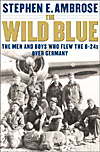By Stephen Ambrose
 Bill Harkins was a B-24 radio operator during WWII. In September Bill read an article in American Heritage magazine about Stephen Ambrose's new book The Wild Blue. Bill reports that this excerpt is a dead on accurate description of his own experiences. In The Wild Blue Ambrose does what he does best - recounting the amazing true stories of America's WWII vets. Anyone that has read one of Ambrose's previous books, or seen the HBO miniseries "Band of Brothers" already has a
good idea of his talents as a storyteller. In this book he concentrates on the B-24 crews, including George McGovern.
Bill Harkins was a B-24 radio operator during WWII. In September Bill read an article in American Heritage magazine about Stephen Ambrose's new book The Wild Blue. Bill reports that this excerpt is a dead on accurate description of his own experiences. In The Wild Blue Ambrose does what he does best - recounting the amazing true stories of America's WWII vets. Anyone that has read one of Ambrose's previous books, or seen the HBO miniseries "Band of Brothers" already has a
good idea of his talents as a storyteller. In this book he concentrates on the B-24 crews, including George McGovern.
Excerpted from The Wild Blue by Stephen Ambrose (first appeared in Sept. 2001 issue of American Heritage magazine).
The B-24 was built like a 1930s Mack truck, except that it had an aluminum skin that could be cut with a knife. It could carry a heavy load far and fast, but it had no refinements. Steering the four-engine airplane was difficult and exhausting, as there was no power except the pilot's muscle. It had no windshield wipers, so the pilot had to stick his head out the side window to see during a rain. Breathing was possible only by wearing an oxygen mask - cold and clammy, smelling of rubber and sweat - above 10,000 feet. There was no heat, despite temperatures that at 20,000 feet and higher got as low as 40 or even 50 degrees Fahrenheit below zero. The wind blew through the airplane like fury, especially from the waist gunners' windows and whenever the bomb-bay doors were open. The oxygen mask often froze to the wearer's face. If the men at the waist touched their machine guns with bare hands, the skin froze to the metal.
There was no aisle to walk down, only the eight-inch-wide catwalk running beside the bombs and over the bomb-bay doors to move forward to aft. It had to be done with care because the aluminum doors, which rolled up into the fuselage instead of opening outward on a hinge, had only a 100-pound capacity, so if a man slipped, he would break through. The seats were not padded, could not be reclined, were cramped into so small a space that a man had almost no chance to stretch and none whatsoever to relax. Absolutely nothing was done to make it comfortable for the pilot, the copilot, or the other eight men in the crew, even though most flights lasted for 8 hours, sometimes 10 or more. The plane existed and was flown for one purpose only: to carry 500- or 1,000-pound bombs and drop them accurately over enemy targets.
Back to SJCW The Volunteer Fall 2001 Table of Contents
Back to SJCW The Volunteer List of Issues
Back to Master Magazine List
© Copyright 2001 by SJCW
This article appears in MagWeb (Magazine Web) on the Internet World Wide Web.
Other military history articles and gaming articles are available at http://www.magweb.com